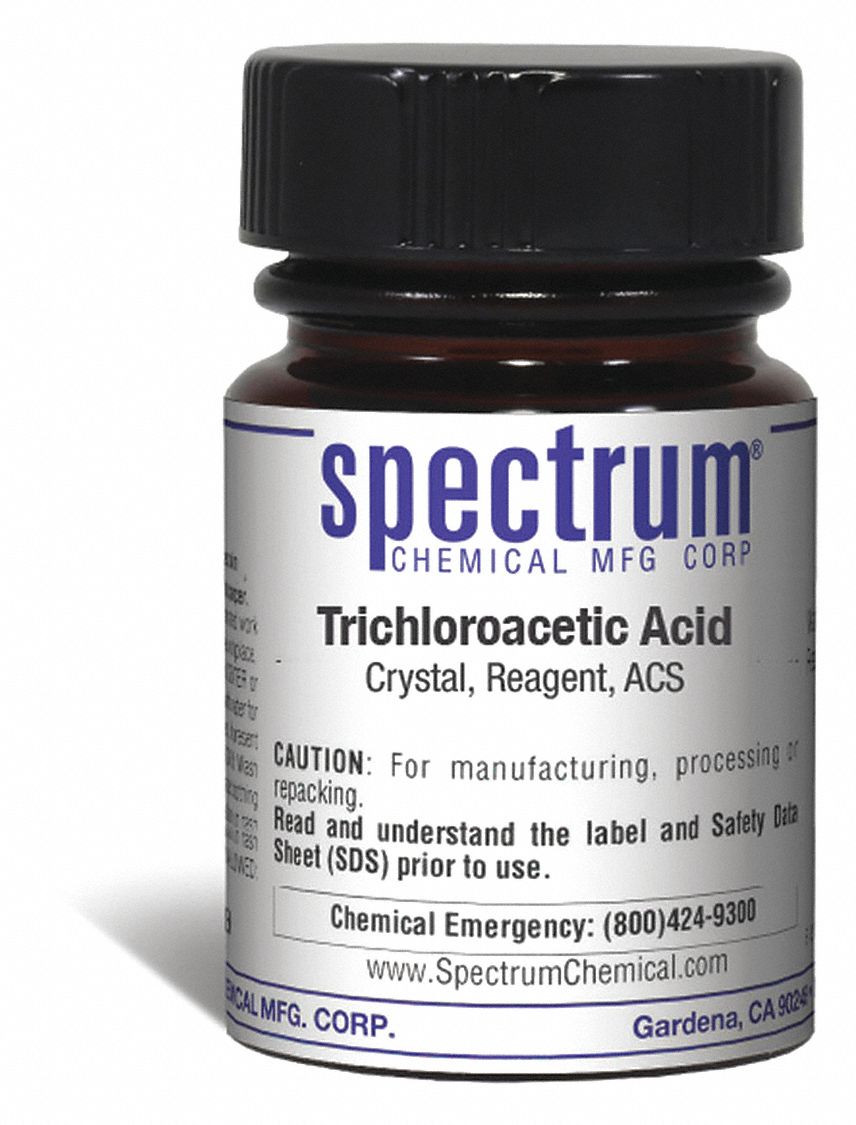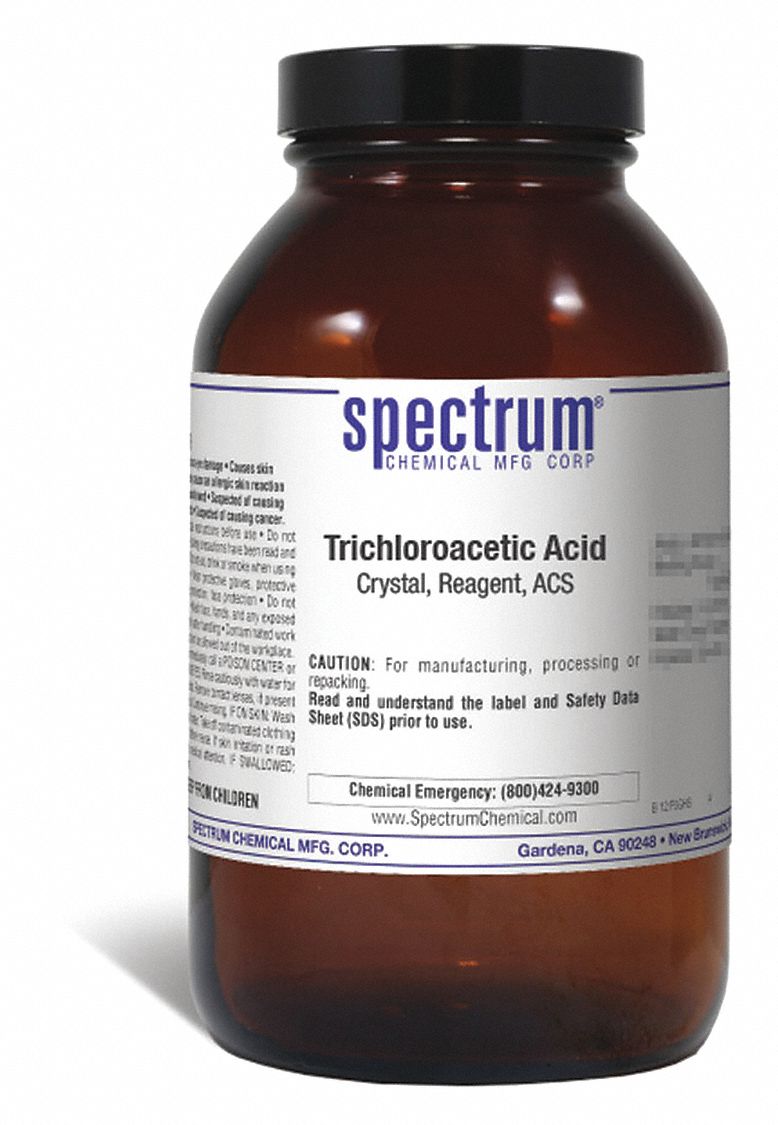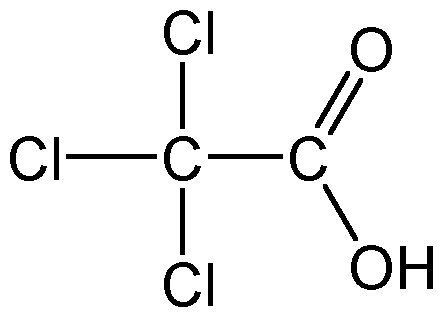Trichloroacetic acid, often known as TCA, is that rather interesting chemical compound with a surprisingly wide range of applications. It's a substance that, in a way, touches various aspects of our lives, from science labs to beauty routines, and even in how we manage certain health conditions. This compound, which is a chlorine version of acetic acid – the stuff found in vinegar, you know – has a very distinct chemical makeup. It's a monocarboxylic acid, and basically, all three hydrogen atoms in the methyl group of acetic acid are swapped out for chlorine atoms. So, it's a bit of a strong cousin to a common household item, but with a much more powerful punch.
You see, trichloroacetic acid is not just a simple chemical; it plays a role as a metabolite, which means it's involved in the body's processes, and it's even been noted as a carcinogenic agent in some studies, and a mouse metabolite too. This dual nature, where it has practical uses but also carries certain risks, is what makes it so important to understand. It's available in different amounts and purities, which is pretty common for chemicals, and this variety allows it to be used in very specific ways across different fields, which is quite fascinating, if you think about it.
When we talk about trichloroacetic acid, we're really talking about a substance that's both incredibly useful and, at the same time, needs to be handled with a good deal of care. It's a strong acid, and very corrosive, which means it can cause damage to skin, eyes, and other body parts if it comes into contact with them. So, it's not something you just mess around with, you know? Its properties make it very effective for certain tasks, but also mean that safety is a top concern whenever it's being used. It's a pretty powerful chemical, and that's something to remember.
Table of Contents
- What Exactly Is Trichloroacetic Acid?
- TCA in Cosmetics: The World of Chemical Peels
- TCA for Medical Uses: Treating Warts
- Beyond Beauty and Medicine: Other Applications
- Safety and Handling: What You Need to Know
- Frequently Asked Questions About Trichloroacetic Acid
What Exactly Is Trichloroacetic Acid?
Trichloroacetic acid, or TCA, is that organic chemical compound we're talking about, and it's quite unique. It's an analogue of acetic acid, which basically means it's structured very similarly, but with a key difference: all three hydrogen atoms that usually sit on the methyl group in acetic acid are replaced by chlorine atoms. This substitution, in a way, changes its entire personality and how it behaves chemically. Its chemical formula is Cl3CCOOH, or sometimes written as CCl3COOH, and it's also known by another name, trichloroethanoic acid, which is pretty much the same thing.
Typically, this substance appears as a colorless, hygroscopic crystalline solid. Hygroscopic means it readily absorbs moisture from the air, which is a rather important characteristic for chemists working with it. It also has a sharp, pungent odor, which is often a tell-tale sign of strong acids. Because it's a strong acid, it's also considered a corrosive substance. This corrosive nature is why it can cause damage to skin, eyes, and other tissues if there's direct contact. So, you know, handling it needs a lot of care, obviously.
This compound is derived from acetic acid, and it's classified as a toxic and corrosive monocarboxylic acid, and also an organochlorine compound. The fact that it's an organochlorine compound means it contains carbon, hydrogen, and chlorine, which gives it certain properties that are useful in various applications. It's pretty much a workhorse in some fields, but with a need for strict safety protocols. It's available in different purities and quantities, as a matter of fact, which allows for its very specific uses across different industries and research areas.
TCA in Cosmetics: The World of Chemical Peels
One of the most widely recognized uses of trichloroacetic acid, or TCA, is in the world of cosmetics, specifically in what are known as TCA peels. These are a type of chemical peel that use trichloroacetic acid to help exfoliate the skin and, in a way, improve its overall look. These peels come in a variety of strengths, or concentrations of the acid, which allows for different levels of skin treatment, from very light to more intense. The concentration used really depends on what skin issue is being addressed and how deep the peel needs to go, you know?
A TCA peel works by applying the acid to the skin, which causes a controlled injury to the outer layers. This controlled damage then prompts the skin to shed, revealing fresher, smoother skin underneath. It's a process of renewal, really. People often consider these peels for a range of skin concerns, and it's almost a common option for those looking to refresh their complexion. The goal is to get rid of damaged skin cells and encourage new, healthier skin to grow, which can make a noticeable difference in appearance.
Benefits of TCA Peels
When it comes to the benefits of TCA peels, there are several reasons why people choose this treatment. One of the main benefits is its ability to improve the look of acne scars. For many, acne scars can be a persistent and frustrating issue, and TCA peels can help to smooth out the skin's texture, making those scars less noticeable. This is, you know, a pretty big deal for people who've struggled with acne for years.
Another significant advantage is its effectiveness against hyperpigmentation. This includes issues like dark spots, sun spots, and melasma, which are areas where the skin has become darker than the surrounding skin. TCA peels can help to lighten these areas, leading to a more even skin tone. So, if you're dealing with uneven skin color, this could be a consideration. It's also quite good for addressing sun damage, which often manifests as fine lines, wrinkles, and rough skin texture. By encouraging new skin growth, TCA peels can help to reduce the visible signs of sun exposure, giving the skin a fresher appearance, which is pretty neat.
Beyond these specific concerns, TCA peels can generally improve the skin's overall texture and radiance. They can help to reduce the appearance of fine lines and wrinkles, making the skin look smoother and younger. The process of exfoliation also helps to unclog pores and can contribute to a clearer complexion. So, in a way, it's a comprehensive treatment for various skin issues, offering multiple benefits for those seeking skin improvement. You can learn more about skin treatments on our site, which is helpful.
Understanding TCA Peel Risks and Costs
While TCA peels offer some compelling benefits, it's really important to understand that they also come with certain risks and considerations regarding cost. As a strong acid, trichloroacetic acid can, you know, cause side effects. Common side effects include redness, swelling, and peeling, which are all part of the recovery process. However, more serious risks can include infection, scarring, and changes in skin pigmentation, especially if the peel is not done correctly or if proper aftercare isn't followed. It's not something to take lightly, obviously.
The intensity of these side effects and risks often depends on the concentration of the acid used and the individual's skin type. Darker skin tones, for instance, might be more prone to post-inflammatory hyperpigmentation, where the skin darkens after the peel. So, it's very important to have a thorough consultation with a qualified healthcare provider or skincare professional before undergoing a TCA peel. They can assess your skin, discuss your goals, and explain the potential risks specific to your situation. This is, as a matter of fact, a crucial step to ensure safety and good results.
Regarding costs, TCA peels can vary quite a bit depending on the strength of the peel, the area being treated, and the provider's location and experience. It's not a one-time fee, either, as multiple sessions might be recommended to achieve the desired results, especially for more significant skin concerns like deep acne scars or extensive sun damage. So, when considering a TCA peel, it's wise to get a clear understanding of the total cost, including any follow-up appointments or recommended skincare products for post-peel care. This financial planning is, in a way, just as important as understanding the medical aspects.
TCA for Medical Uses: Treating Warts
Beyond its cosmetic applications, trichloroacetic acid also has a significant role in medical treatments, particularly as a topical gel used to treat genital warts and anal warts. This is a very specific application where its corrosive properties are used therapeutically. The acid works by destroying the wart tissue, causing it to, you know, essentially break down and eventually fall off. It's a direct and targeted approach to removing these growths, which can be quite bothersome for those who have them.
When used for warts, trichloroacetic acid is typically applied by a healthcare provider. This is important because they can ensure the smallest amount of medication is used and applied precisely to the wart, avoiding surrounding healthy skin as much as possible. This careful application is crucial to prevent skin problems and minimize side effects. The treatment can be repeated weekly as needed, depending on how the wart responds to the acid and the patient's tolerance. So, it's not always a one-and-done thing.
While effective, the gel can sometimes cause skin irritations and pain. This is, you know, a common side effect given its strong, corrosive nature. Your provider will monitor these reactions and adjust the treatment plan accordingly to manage discomfort. Understanding how it works, what side effects it may cause, and how it compares with other medications for warts is something your healthcare provider will discuss with you. It's a pretty common treatment option, but like all medical procedures, it comes with its own set of considerations. You can find more information about medical treatments on our site.
Beyond Beauty and Medicine: Other Applications
Trichloroacetic acid's versatility extends far beyond just cosmetic peels and wart treatments; it's also a key player in various other fields, which is pretty interesting. In biochemistry, for example, it's used in macromolecule precipitation. This means it helps to separate large biological molecules like proteins and nucleic acids from solutions, which is a rather important step in many research and diagnostic processes. So, it's a tool that helps scientists understand life at a very small scale, you know?
It also finds use as a fixative in microscopy. When scientists want to look at cells or tissues under a microscope, they often need to preserve them in a way that maintains their structure. Trichloroacetic acid can be part of the solutions used for this purpose, helping to prepare samples for detailed examination. This role is, in a way, fundamental to biological research and diagnostics, allowing us to see what's usually invisible to the naked eye.
Furthermore, trichloroacetic acid acts as a reagent in organic synthesis. This means it's a substance used to cause a chemical reaction, helping to create new organic compounds. In this capacity, it's a building block or a catalyst in the creation of other chemicals, which is pretty vital for the chemical industry and for developing new materials. It's also been used in pesticides and herbicides, which is another application that shows its broad utility, though these uses also come with environmental considerations, obviously.
Its esters and salts are termed as trichloroacetates, which also have their own set of applications. For instance, sodium trichloroacetate has been evaluated alongside trichloroacetic acid in certain contexts. This highlights that the compound itself, and its derivatives, are subjects of ongoing study and application across many different areas. You can often browse trichloroacetic acid and related products at scientific supply companies, which just goes to show how widely used it is in research and industry, as a matter of fact.
Safety and Handling: What You Need to Know
Given that trichloroacetic acid is a toxic, corrosive monocarboxylic acid, understanding its safety aspects and proper handling is, you know, absolutely critical. It's a strong acid, and as mentioned, it can cause significant damage to skin, eyes, and other tissues upon contact. This means that anyone working with it, whether in a lab or a clinical setting, needs to follow very strict safety guidelines. Protective equipment, such as gloves and eye protection, is not just recommended; it's pretty much essential to prevent accidental exposure.
The corrosive nature of trichloroacetic acid also means it can be corrosive to metals. This is an important consideration for storage and the types of containers it's kept in. Proper ventilation is also key, as strong acids can emit fumes that might be irritating or harmful if inhaled. So, working in a well-ventilated area or under a fume hood is typically required in laboratory settings. These precautions are, in a way, standard practice for handling strong chemicals, but they're particularly important for TCA.
The International Agency for Research on Cancer (IARC) has considered trichloroacetic acid in its working groups in the past, specifically in 1995 and 2004. New data has become available since then, and along with information about sodium trichloroacetate, this has been taken into consideration in more recent evaluations. This ongoing review by organizations like IARC underscores the importance of continuously assessing the potential health impacts of such compounds. For detailed data, organizations like NIST subscription sites provide data under the NIST Standard Reference Data Program, though they often require an annual fee to access, which is something to keep in mind if you're looking for very specific technical information. This shows, in a way, the depth of scientific inquiry into this compound.
For industrial or occupational settings, guidelines for safe handling and exposure limits are often set by regulatory bodies. For example, sampling instructions are recommended guidelines for OSHA compliance safety and health officers (CSHOs), and they refer to corresponding OSHA method references for complete details. This kind of detailed guidance ensures that workers who might be exposed to trichloroacetic acid in their jobs are protected. So, it's not just about personal care; it's about workplace safety too, which is, you know, a big deal.
Frequently Asked Questions About Trichloroacetic Acid
What is trichloroacetic acid used for in simple terms?
Basically, trichloroacetic acid is used for a few different things. In cosmetics, it's a key ingredient in chemical peels to help improve skin appearance, like reducing acne scars or dark spots. In medicine, it's a topical gel used by healthcare providers to treat warts. And in science, it helps separate big molecules in experiments and is used to preserve samples for microscopy. So, it's quite versatile, you know?
Is trichloroacetic acid safe to use on skin?
When used by a trained professional in controlled concentrations, like in TCA peels or for wart treatment, it can be safe. However, it's a strong, corrosive acid, so it can cause skin irritation, pain, and potentially more serious issues if not applied correctly or if the concentration is too high. That's why it's very important that a healthcare provider or experienced professional applies it, obviously, to ensure safety and prevent problems.
What are the common side effects of TCA peels?
After a TCA peel, you can typically expect some redness, swelling, and peeling of the skin. This is a normal part of the skin's renewal process. Some people might experience a bit of discomfort or pain during the application. Less common, but more serious, side effects can include infection, scarring, or changes in skin color, especially if proper aftercare isn't followed. So, it's good to be aware of these possibilities.
Trichloroacetic acid, or TCA, is a chemical compound with a pretty broad reach, from cosmetic enhancements to specific medical treatments and even crucial roles in scientific research. Its unique chemical structure, an analogue of acetic acid with chlorine substitutions, gives it powerful properties that make it effective for exfoliation, tissue destruction, and biochemical processes. While it offers notable benefits for skin improvement and wart removal, it's really important to remember its corrosive and toxic nature. So, safe handling and professional application are, you know, always key. Understanding its various applications and the necessary precautions helps us appreciate this compound's significance in many different fields. It's a very interesting chemical, and its uses continue to be explored and refined.



Detail Author:
- Name : Carmella Ziemann
- Username : wyman75
- Email : sophie88@hotmail.com
- Birthdate : 1986-03-14
- Address : 7066 Lurline Plains New Kennedi, WI 50753
- Phone : +1-414-947-8684
- Company : Lind-Kuphal
- Job : Director Of Marketing
- Bio : Omnis est et aut aut voluptatem sed. Deleniti voluptatem officiis in quaerat fugiat ut nesciunt. Architecto fugit in magni quasi.
Socials
twitter:
- url : https://twitter.com/gillian.conroy
- username : gillian.conroy
- bio : Suscipit atque vero culpa voluptas rerum. Ullam ex repudiandae voluptates occaecati consequatur aut. Adipisci id sequi consequatur iusto suscipit.
- followers : 6353
- following : 1337
instagram:
- url : https://instagram.com/conroyg
- username : conroyg
- bio : Quod nihil enim quas laborum aperiam veritatis. Temporibus odit delectus ut possimus.
- followers : 5049
- following : 1716
facebook:
- url : https://facebook.com/conroyg
- username : conroyg
- bio : Eos totam est corporis. Minus veritatis delectus iste omnis.
- followers : 876
- following : 2369
linkedin:
- url : https://linkedin.com/in/conroyg
- username : conroyg
- bio : Eos molestiae eos hic explicabo perferendis.
- followers : 4273
- following : 713



























